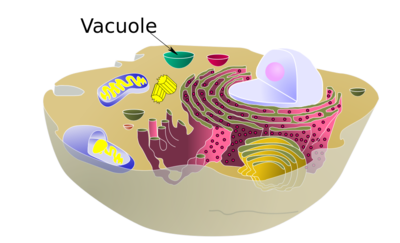Vacuole
|
|
Vacuoles are large membrane-bound compartments within some eukaryotic cells where they serve a variety of different functions: capturing food materials or unwanted structural debris surrounding the cell, sequestering materials that might be toxic to the cell, maintaining fluid balance (called turgor) within the cell, exporting unwanted substances from the cell, or even determining relative cell size. The cavity that is the vacuole is considered nonprotoplasmic and the contents classified as ergastic according to some authors (Esau, 1965). Vacuoles are especially conspicuous in most plant cells.
Vacuoles are typically filled with a liquid called cell sap, the composition of which can vary (even between vacuoles in the same cell), but is principally water. Water tends to move along concentration gradients into vacuoles. Vacuoles perform different roles in different organisms and these functions include the capture of food, the maintenance of internal hydrostatic pressure (store water), the containment of waste products, the maintenance of an acidic internal pH, the storage of small molecules and finally can enable a cell to elongate rapidly.
Examples of vacuoles that perform each of these functions in different organisms are described below.
| Contents |
Vacuoles in protists
Some protists and macrophages use food vacuoles in phagocytosis—the intake of large molecules, particles, or even other cells, by the cell for digestion.
A contractile vacuole is used to pump excess water out of the cell to reduce osmotic pressure and keep the cell from bursting. Contractile vacuoles are found in some freshwater protozoa.
Vacuoles in plant cells: the central vacuole
Most mature plant cells have a central vacuole, which often takes up more than 80% of the cell interior. It is surrounded by a membrane, called the tonoplast. This vacuole houses large amounts of water, enzymes, inorganic ions (such as calcium) and other substances, like toxic byproducts which are hence removed from the cytosol. By letting protons in, it helps in keeping the cell's pH stable, while making its interior more acidic which is necessary for the degradative enzymes. Even though having a single, big vacuole is the most common case, the size and number of vacuoles may vary in different tissues and stages of development. Cambium cells, for example, have many small vacuoles in winter, and a large one in summer.
The central vacuole's main role (besides being a storage center) is to keep a turgor pressure against the cell wall (thanks to water storage); if it fails at this (by losing water) the cell will plasmolyse. This is why the central vacuole is so comparatively large in the plant cell. Proteins found in the tonoplast control the flow of water into and out of the vacuole by active transport, pumping ions of potassium (K+) into and out of the interior liquid. Because of osmosis, wherever solutes go, water follows. This pressure is also helpful for cellular elongation: when the cell wall is degraded (not entirely) by the action of auxins, this now less rigid wall is expanded by the pressure coming from within the cell. Yet another function is that it pushes all the cell's cytoplasm against the cellular membrane, and thus keeps the chloroplasts closer to light.
The different roles of the central vacuole are summarized in this list:
- Maintenance of the hydrostatic pressure.
- Storage of organic compounds, proteins (in seeds), and inorganic ions (e.g., K+ and Cl-) and salts (e.g., salts of calcium).
- Separation of toxic byproducts from cell metabolism.
- Storage of pigments (e.g., red and blue pigments in flowers).
- Protection of the plant tissue from predation by storing toxic compounds.
- Contributing to cell growth by absorbing water (e.g., cell elongation).
- Allowing some plant cells to reach considerable size.
Vacuoles in budding yeast cells
In budding yeast cells, vacuoles are the storage compartments of amino acids and the detoxification compartment, which are described in previous topics. Recently, vacuoles of budding yeast cells have been studied. As a result, another function of vacuoles was discovered. Under conditions of starvation, proteins are degraded in vacuoles; this is called autophagy. First, cytoplasms, mitochondria, and small organelles are covered with multiplex plasma membranes called autophagosomes. Next, the autophagosomes fuse the vacuoles. Finally, the cytoplasms and the organelles are degraded.
In a vacuole of budding yeast, a black particle sometimes appears. It is called a dancing body. The dancing body moves actively in the vacuole and appears and disappears within 10 minutes to several hours. In previous research, it was suggested but not proven that the main component of the dancing body is polyphosphate acid. But the main component has been determined to be crystallized sodium polyphosphate and its function has been studied. It is thought that its function is to supply and store phosphates in budding yeast cells.
References
- Esau, K. 1965. Plant Anatomy, 2nd Edition. John Wiley & Sons. 767 pp.
| Organelles of the cell |
|---|
| Chloroplast | Mitochondrion | Centriole | Endoplasmic reticulum | Golgi apparatus | Lysosome | Myofibril | Nucleus | Peroxisome | Ribosome | Vacuole | Vesicle |

